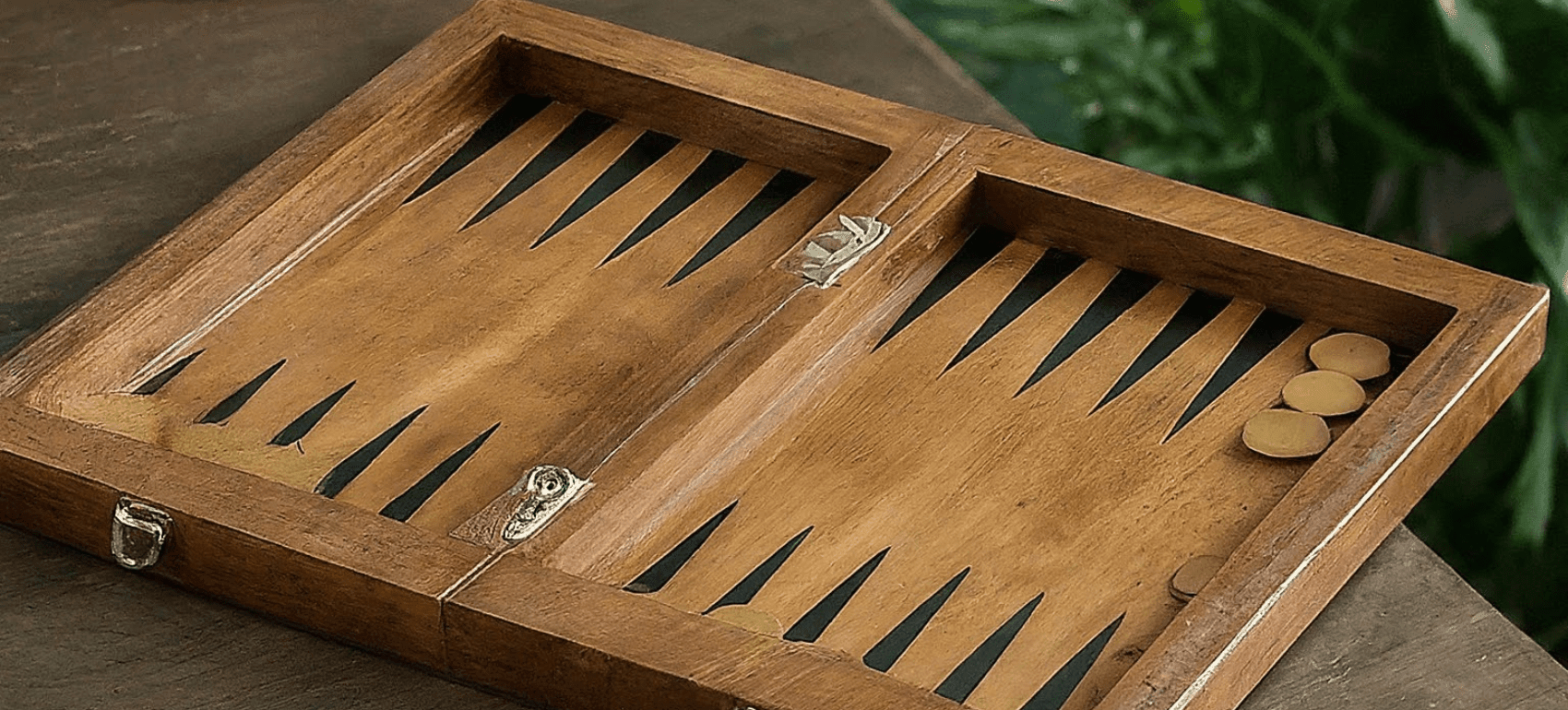
5 Advanced Strategies to Dominate the Backgammon Board
Understanding the Fundamentals: Preparing for Advanced Play
Before players can delve into the intricate world of advanced strategies on the backgammon board, it is essential to have a firm grasp of the game’s fundamentals. Like a set of large wooden chess pieces on an intricately designed board, each move in backgammon should be made with intention and strategic foresight. Successful players understand the necessity of proper groundwork in order to manipulate the game in their favor.
Here are some fundamental aspects to master:
Basic Rules and Objectives: Players must be clear on how to move pieces according to the dice rolls, the goal of bearing off all pieces before the opponent, and the various starting positions.
Opening Moves: Recognize the best opening plays and how they can lead to advantageous positions. These first few moves can set the stage for the entire game.
Probability and Risk Management: Familiarize with the dice probabilities to anticipate potential outcomes. Strategic risk-taking is often the difference between winning and losing.
Protecting Pieces: Learning how to keep your pieces safe from hits is crucial. This involves understanding the concept of anchors and blots.
Basic Tactics: This includes hitting, blocking, and building a strong home board. Like strategically placing beautiful chess pieces to control the chessboard, these tactics help maintain the momentum in backgammon.
Doubling Cube Usage: Knowing when to offer or accept a double can significantly impact the final outcome. The doubling cube is a powerful tool if used aptly.
Invest the time to assimilate these essentials, for they are the foundation upon which advanced strategies are constructed. Just as one might cherish a luxury chess set, gifted for dad on a special occasion, backgammon players must value the depth and complexity of the game’s foundational elements to pave the way for advanced play. Only then can a player artfully maneuver the backgammon board with the deftness and grace required to dominate the competition.
Strategic Opening Moves: Setting the Stage for Domination
In the realm of backgammon, the initial throws and corresponding strategic placements can set an indomitable tone for the game. Savvy players understand the potency of a well-crafted opening move, much like the commanding presence of a set of wooden chess pieces artfully arrayed on the board. Anticipation and foresight are key components in curating an approach that organizes the checkers for offensive and defensive maneuvers.
- Opening Rolls: Distinct opening rolls are favored in backgammon. A roll of 3-1, for instance, allows a player to make both a defensive anchor in their home board and an offensive point in their outer board. This mimics the diverse capabilities of a set of large wooden chess pieces – each move holds specific strategic value.
- Flexibility: Building a flexible position akin to the versatile luxury chess pieces, grants players the ability to adapt and reposition based on the opponent’s moves. Deploying checkers to points where they can move freely without forced hits is a strategy that keeps options open.
- Blocking and Priming: Early in the game, establishing well-placed blocks can impede an opponent’s progression much like strategically positioned chess pieces control the center of the chessboard. Likewise, forming a prime—a consecutive series of occupied points—can trap an opponent’s checkers.
- Advanced Anchor: Securing an advanced anchor deep in the opponent’s home board presents a valued gift for dad in the strategic play of backgammon. This move fortifies a player’s position while compromising the opponent’s ability to build a strong home board.
Approaching with a cautious yet aggressive mindset, using these strategic opening moves, can fortify a player’s control over the game. Every roll is the intricate step in crafting an overall narrative of eventual domination on the backgammon board.
Probabilistic Analysis: Making Informed Decisions on the Board
In the intricate game of backgammon, akin to a set of wooden chess pieces art 809125, each movement can culminate in a variety of ensuing scenarios. A proficient player must use probabilistic analysis to forecast potential outcomes and optimize their tactics on the board. This approach imparts a statistical evaluation of moves, considering the probability of dice results and subsequent opportunities or risks.
Calculating the odds of dice rolls is foundational in backgammon. A player should appraise how likely specific dice combinations are and how they might alter the board’s state. For instance, when deciding whether to leave a blot, one needs to evaluate the opponent’s chances of hitting it on the next turn. A sound decision hinges on the balance between the likelihood of an adverse event and the strategic advantage gained by taking a risk.
Control of decision making also extends to the use of the doubling cube. A nuanced understanding of the statistical outcomes enables one to propose or accept doubles judiciously, enhancing winning probabilities. Experienced players recognize when the odds of winning exceed the risk, turning the doubling cube into a potent tactical tool.
Moreover, in the endgame, probabilistic analysis becomes even more pivotal. Decisions on whether to race, block, or hold a position rely heavily on the distribution probabilities of future rolls. An airtight endgame strategy takes into account the frequencies of all possible dice combinations and their implications for crossing the finish line.
In leveraging probabilistic analysis, backgammon transforms into a contest of foresighted strategy. Just as a set of large wooden chess pieces, luxury chess pieces, beautiful chess pieces, or a gift for dad would be chosen with careful thought, every move in backgammon requires deliberation and foresight, with the understanding that statistical underpinnings often presage the victor on this time-honored board.
Backgame Tactics: Turning the Tables When Behind
In the intricate dance of backgammon, falling behind does not spell defeat if one deploys backgame tactics with precision. Designed as a defensive strategy, the backgame leverages multiple anchors in the opponent’s home board or outer board to orchestrate a tactical comeback. To execute this, players must ensure a stronghold by establishing two or more points in these key areas. These strongholds then serve as both a blockade and a springboard for attacking, as opportunities arise.
Implementing backgame tactics requires a delicate balance. Players must hold their positions with tenacity while keeping an eye out for vulnerabilities in the opponent’s formation. The key is to wait for the opportune moment when the adversary leaves a blot— an exposed checker. Seizing these blots can swing the momentum, penalizing the opponent’s progress and potentially capturing their checkers, which can turn the tides of the game.
Backgame strategy demands patience and a knack for timing. A premature break from the stronghold could unravel the defensive web woven so carefully. The player must judiciously choose when to leap forward, committing only when the dice rolls and positional play suggest a shift in the power dynamic is plausible.
Moreover, adept backgammon aficionados are aware that successful backgame play also requires impeccable timing of the bear-off process. Knowing when to start bearing off while maintaining backgame positions is crucial. If executed too early, the player risks losing the anchors that could be essential for a comeback; too late, and the adversary may solidify their lead beyond reach.
To maximize the efficacy of backgame techniques, players should practice defensive play, ready to pivot and seize aggressive opportunities as they manifest. By mastering backgame tactics, players can turn seemingly bleak situations into surprise triumphs, often to the astonishment of their opponents, much like a cunningly played set of wooden chess pieces artfully turning the tide of a game.
Doubling Cube Strategies: When to Double and When to Accept
Mastering the doubling cube is crucial for advanced backgammon players. Here’s how to wield it like a set of beautiful chess pieces, each move an art of precision and foreseeing the endgame.
When to Double:
- Assess Your Position: Economize the decision to double by evaluating your position compared to your opponent’s. If you hold a significant advantage, be it through a better home board, fewer checkers on the bar, or advanced anchors, implementing the cube can increase pressure.
- Consider the Stakes: In a situation akin to gifting a dad with a set of large wooden chess pieces, doubling at the right moment can be a grand gesture that tilts the game in your favor. If the game is at a critical juncture and you stand to win a considerable amount, it’s often the right time to double.
- Match to the Match Score: In tournament play, the match score influences doubling strategy. Like planning moves with luxury chess pieces, calculate how the potential double impacts the overall match. For example, doubling during a Crawford game can be a pivotal decision.
When to Accept a Double:
- Calculate the Risk vs. Reward: Just as you would painstakingly select a set of wooden chess pieces, art 809125, accepting a double requires meticulous consideration. If you have a reasonable chance (>25%) to win the game, or if the potential loss is significantly less damaging than the gain, accepting may be wise.
- Anticipate your Opponent’s Play: In chess, predicting your opponent’s moves with each piece is essential. Similarly, in backgammon, if you foresee your position improving shortly, it might be worth accepting the double.
- Understand the Resilience of Your Position: Evaluate if your structure is solid enough to withstand a potential onslaught. Like choosing a gift for dad that requires thought about its longevity, accepting a double necessitates confidence in your game’s enduring strength.
Every move with the doubling cube should be intentioned and strategic, holding the capacity to craft the fate of the game.
Prime Formation: Building and Breaking Barriers
Backgammon strategy often hinges on the effective deployment of primes—a connected series of occupied points that prevent an opponent’s checkers from advancing. Constructing a prime can be likened to assembling a set of wooden chess pieces, where each piece plays a critical role in the game’s defensive and offensive dynamics.
To excel at forming primes:
Understand the Extendable Prime: Aim for at least a six-point prime, which can trap an opponent’s checker behind a formidable barrier. It’s not unlike investing in a set of large wooden chess pieces – the more substantial your prime, the grander your control of the board.
Play Flexibly: When building your prime, ensure you have builders in place to extend the prime if necessary. These builders are like the pawns of a luxury chess piece set, seemingly innocuous but pivotal in fortifying your position.
Timing is Key: Construct your prime as your opponent is on the bar or has a checker trapped behind your blockade, mirroring the strategy used in the game of chess; timing your moves for maximum effect can lead to a significant advantage.
Breaking opponent primes requires different tactics:
Develop Escape Routes: Just as the knight in a chess set moves in an unconventional pattern to slip past barriers, look for opportunities to escape an opponent’s prime. This may mean advancing a checker to a more favorable position to leap over the barricade when able.
Pounce on Weak Points: Identify the weakest link in your opponent’s prime and position your checkers to capitalize on any shifts or gaps. A beautiful chess piece strategically placed for the capture of an opponent’s piece can be paralleled with placing pressure on a prime’s vulnerable spot.
Use Holding Points: Like a gift for dad that keeps giving, holding points within your opponent’s home board can serve as a continuous threat, forcing them to leave blots as they try to move forward.
To sum up, prime formation and disruption are akin to the manipulation of pieces in a chess game. Mastery of these tactics will significantly enhance a player’s command of the backgammon board.
Blot Hitting and Reentry: Balancing Risk and Reward
To dominate the backgammon board, one must deftly balance the art of aggression with strategic defense. Blot hitting and reentry play a pivotal role in this balancing act, posing both risks and rewards for the player. While hitting a blot can set an opponent back, offering an edge in the race, overaggressiveness may lead to vulnerability—posing a risk akin to the exposed king in a set of large wooden chess pieces.
In the realm of blot hitting, one must assess the board with precision and foresight. Consider these factors:
- Player’s overall strategy: If your approach is to establish a strong home board or to blockade, hitting external blots might not align with this plan unless it strategically impedes your opponent.
- The opponent’s board strength: Targeting a blot is advisable when the opponent has a weak home board, increasing the chances of safely reentering your own checker.
- Positioning of remaining checkers: Ensure that in the pursuit of hitting a blot, you’re not unnecessarily exposing your checkers, turning your offensive move into a defensive predicament.
When a checker is hit, focusing on reentry is of utmost importance. Immediate reentry minimizes the time spent on the bar and keeps the momentum in your favor. The process of reentry should be approached with caution:
- Assess the safest point of reentry in relation to the opponent’s home board.
- Aim for reentry on a point that provides immediate opportunities for advancement or allows for secure positioning.
- Understand that sometimes it’s worth waiting for a better reentry position if it means avoiding a trap set by your opponent.
While a perfectly executed hit can be as satisfying as gifting a beautiful chess set to a beloved dad, it’s essential always to measure the risk versus the expected reward. In backgammon, as in chess, the tide of the game can change with a single move. Thus, advanced players always calculate the potential outcomes before engaging in battles over blots and reentry.
Anchoring Strategies: Securing Strongholds in Enemy Territory
In the intricate dance of backgammon, establishing anchors in your opponent’s home board can be compared to placing a set of wooden chess pieces artfully within enemy lines. Anchoring is a forward defense, much like a strategic deployment of beautiful chess pieces in a chess match, which can impede your opponent’s progress and provide a safe haven for your own checkers.
Here are several anchoring strategies that can fortify positions deep within hostile territory:
Create Advanced Anchors: Strive to occupy points in your opponent’s home board early in the game. This is akin to positioning a set of large wooden chess pieces on the board, asserting your influence expansively.
The 20-Point Anchor: Holding the 20-point anchor provides a valuable strategic base close to your home board. It acts as a deterrent, much like luxury chess pieces that command attention and perseverance from the opposition.
Back-to-Back Anchors: When possible, try to establish two anchors in a row. This strategic formation can block your opponent’s checkers from advancing, mirroring the satisfaction of a well-crafted defensive tactic in chess.
Bar-Point Anchor: The bar-point, or the 7-point, is a vital strategic location. Securing an anchor here can be a game-changer, comparable to giving a gift for dad that holds both sentimental and practical value.
Opponent’s Five-Point Anchor: Establishing an anchor on your opponent’s five-point not only secures a strategic stronghold but also disrupts your opponent’s ability to create an ideal home board.
These anchoring strategies serve a dual purpose. They provide defensive stability while also keeping pressure on the opponent’s formation. By combining these tactical maneuvers, a player can transform the backgammon board into a battlefield where every point controlled is a step towards ultimate victory, just as every carefully chosen move with a chess piece brings a player closer to checkmate.
End-Game Scenarios: Techniques for Bearing Off
In the strategic universe of backgammon, the bearing-off phase is crucial for victory, akin to maneuvering a set of large wooden chess pieces in the endgame of chess. Players must shift from aggressive positioning to a calculated race, ensuring each move is as efficient as possible.
When bearing off, one technique is to balance the checkers across the home board. This minimizes the chances of a blot being hit and having to re-enter an opponent’s home board late in the game. Efficiency is key – look to bear off multiple checkers with a single roll where possible.
Another advanced strategy is the use of “pip count” – an aggregate sum of points that checkers must move to bear off. Expert players keep a keen eye on the pip count, aiming to reduce it quickly while also considering the opponent’s count. It’s a dance of numbers, guiding each decision on the board.
In situations where both players are bearing off, prioritizing safety over aggression becomes paramount. Shifting checkers to avoid leaving single pieces vulnerable is a conservative, yet a strategically sound approach. This proverbial “race” rewards precision, as a single mistake can shift momentum drastically.
One should also consider the “combination shots” – rolls that allow for multiple bearing-off moves. Employ this when the opportunity arises but avoid overextending to the point of vulnerability.
Lastly, always be adaptive to the changing dynamics. If a player falls behind, they may need to switch from a bearing-off focus to “backgame” – playing for a shot at hitting an opponent’s blot.
Strategically navigating the endgame can bear a resemblance to a beautifully executed series of moves using luxury chess pieces. Each checker’s journey off the board must be planned with foresight and executed with precision, a fitting challenge for a dedicated player seeking to stand victorious in this game of skill and chance.
Adaptive Gameplay: Adjusting Strategies Based on Opponent Behavior
In the nuanced world of backgammon, the adaptability of a player’s approach is as critical as the initial strategy. Just as a set of wooden chess pieces art 809125, each move on the backgammon board requires precise thought and intention. Observing and countering the opponent’s tactics becomes the cornerstone of advanced gameplay.
Players must cultivate an analytical eye, akin to scrutinizing a set of large wooden chess pieces before a decisive move. This involves watching for patterns in an opponent’s play style. Are they risk-averse, or do they take bold chances? Adaptation may mean shifting from a defensive to an aggressive strategy if the opponent is inclined to avoid risks.
Instituting a responsive game plan involves not only changing tactics in reaction to the opponent but also anticipating their future moves. This plays out similarly to selecting luxury chess pieces, where the choice reflects not just the immediate play but several moves ahead. If the opponent begins to play aggressively, consider deploying a backgame strategy, inviting them to establish a prime, only to disrupt it later with timely hits.
Backgammon masters understand the importance of flexible responses. They are like connoisseurs selecting the perfect beautiful chess pieces gift for dad, considering both the present appeal and lasting value. When a player integrates adaptability into their strategy, every move becomes a calculated response to the shifting sands of their opponent’s strategies.
Employing a reactive gameplay style necessitates the readiness to deviate from one’s game plan and improvise. This may involve changing the point of attack, offering a seemingly vulnerable blot as bait, or doubling down at an opportune moment. The key is to keep the opponent off balance, forcing them to confront new problems with each roll of the dice.
Psychology and Bluffing: Implementing Mind Games
In the high-stakes milieu of backgammon, akin to maneuvering a set of wooden chess pieces art 809125 across a checkered board, the art of bluffing is a strategic layer that can disorient and dominate an opponent mentally. Professional players often stress the pivotal role psychology plays, and effectively deploying mind games can lead to a commanding position in game dynamics.
Mastering the psychological aspects involves influencing the opponent’s perception and decision-making processes. The seasoned player must convey confidence, even under the guise of a precarious position, much like positioning a set of large wooden chess pieces with deliberate intent. The facet of bluffing in backgammon is less about deception in the classical sense and more about subtle cues and calculated risk-taking.
Key psychological strategies include:
- Projecting certainty when uncertainty exists, manipulating the opponent’s ability to predict one’s moves.
- Implementing double-edged plays that seem aggressive but serve a defensive purpose, akin to gifting a luxury chess piece to trap a player into a false sense of advantage.
- Feigning a weaker position can sometimes encourage the opponent to take risks, leading to their downfall, reflecting the strategic gift for dad that turns out to be a lesson in overconfidence.
- Controlling the pacing of the game, much in the same way a beautiful chess piece captures attention, can unnerve an opponent and lead to errors.
In the end, these mental tactics, just as in the game of chess, are about finessing the psychological duel that parallels the physical game. Through proficient use of psychology and bluffing, a backgammon player can transmute a seemingly innocuous position into a winning strategy, enforcing the narrative that in the arena of board games, the mind is as influential as the dice.
Learning from the Masters: Incorporating Pro Moves into Your Game
Backgammon, much like a set of large wooden chess pieces laid out before a game, requires strategic foresight and an appreciation for tactics refined through centuries of gameplay. Admirers of crafted gaming components, who may savor the touch of luxury chess pieces or find the perfect gift for dad in a bespoke board, can equally appreciate the depth of strategy that classic games like backgammon offer.
To elevate their play, enthusiasts should study the styles and strategies of backgammon masters. Here are essential tactics employed by the pros that can enhance your game:
Control the Points: Top players focus on controlling key points, especially the 5-point on their side of the board (often dubbed the “golden point”) as well as their opponent’s 5-point. Securing these positions can provide a significant strategic edge.
Timing: Professional backgammon players excel at timing. They understand when to hold their positions and when to break their primes. Timing affects not only the movement of the checkers but also influences decisions to double or accept a double.
Flexibility: The ability to adapt to the changing dynamics of the game is a hallmark of a master. Flexibility in decision-making allows for adjustments based on the roll of the dice and the opponent’s moves.
Calculated Risk-Taking: Pros know when to take risks. Whether it involves leaving a blot to create a more aggressive front line or hitting an opponent’s blot in their home board, calculated risks can lead to advantageous positions.
Practiced End-Game Strategy: The end-game is where many matches are won or lost. Skilled players have a keen sense of the bear off process, and they practice various scenarios to perfect their end-game tactics.
Incorporating these professional moves can transform any backgammon enthusiast from an amateur player into a formidable opponent, just as owning a set of wooden chess pieces art 809125 can inspire a novice chess player to master the game.






